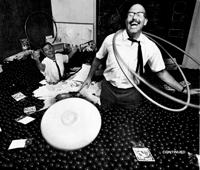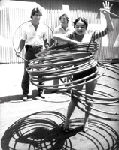
Sixty Years of Wham-O

“If Spud and I had to say what we contributed, it was fun.” - Richard Knerr and Spud Melin. Photos: Wham-O
By any historical measure, the innovations of the Wham-O toy company pale in significance when compared with, say, the discovery of the polio vaccine or the development of the world wide web.
But this is not to say that they are without a place in history. The Hula Hoop, the Water Wiggly sprinkler, the Slip’n’ Slide, the SuperBall and the Frisbee all hold a rightful place in the annals of innovation as products which – while perhaps not life-saving, ground-breaking, or even necessary – were hugely successful in bringing enjoyment to millions of people throughout the world.
The career of Richard Knerr, who with his partner Arthur “Spud” Melin founded Wham-O in 1948, and who died last month at the age of 82 in Arcadia, California, is a testament to the power of the creative impulse to brighten the lives of multitudes. The fact that the pair left a lasting impact on popular culture was no small feat either.

The Hula-Hoop sold 100 million in two years. It was never patentable, but the must-have trademark kept the dollars rolling in. Photos: Wham-O.
Knerr and Melin saw commercial potential in what became the Hula Hoop when an Australian friend visiting California demonstrated a wooden ring used in children’s gym classes down under. The duo refashioned the hoop from brightly-colored, tubular plastic, added beads inside that produced a rhythmic sound to accompany the circular hip-shaking necessary to keep the hoop aloft, and sold 40 million of them in 1958. By 1960 they had sold 100 million worldwide, a record at the time for any toy.
Crazes
The Hula Hoop was perhaps the first fad that was spread by the new medium of television, and remains, according to social historian Richard A. Johnson in his book American Fads, “the standard against which all national crazes are measured.” Indeed, any book or film attempting to capture the zeitgeist of the early years of the Cold War is as likely to feature an image of starry-eyed, gyrating Hula-Hoopers as that of another, more menacing innovation of the era, the mushroom cloud.
Knerr and Melin (who died in 2002) were as much re-inventors as they were inventors. As the Hula Hoop craze was beginning to fade near the turn of the decade, they happened upon the Pluto Platter, a flying disc invented – and sold from his station wagon up and down the California coastline – by Walter Frederick Morrison. Wham-O bought the rights, re-engineered the disc to give it more levitational, flying saucer-like qualities, and re-christened it the Frisbee. The disc has since become standard gear for generations of university students, surfers, and dogs, and has served as the inspiration for a number of competitive sports, many of them invented by Wham-O.

While the bright red-and-white Wham-O trademark became synonymous – at least in the minds of small boys, the company’s core base – with the heights of quality and innovation, Knerr and Melin were not immune to an occasional commercial misjudgement. The Instant Fish (“just add water”) fizzled when dried fish eggs imported from Africa failed to hatch. And the pair’s attempt to capitalize on another craze of the early ’60s – the fear of nuclear annihilation – fell flat when their US$119, do-it-yourself bomb shelter kit failed to capture the public’s fancy.
Still, the two embodied the rare combination of inventiveness, creativity, and an appetite for frequent, over-the-top risk-taking that is often necessary to turn inspiration into tangible products and commercial success. Knerr often credited Wham-O’s achievements to working in an environment that encourages innovative thinking and an entrepreneurial bent. “If Spud and I had to say what we contributed, it was fun,” Knerr said in a 1994 interview with the Los Angeles Times. “But this country gave us the opportunity to do it.”
By John Tarpey, WIPO Communications and Public Outreach Division.
Related Links
The WIPO Magazine is intended to help broaden public understanding of intellectual property and of WIPO’s work, and is not an official document of WIPO. The designations employed and the presentation of material throughout this publication do not imply the expression of any opinion whatsoever on the part of WIPO concerning the legal status of any country, territory or area or of its authorities, or concerning the delimitation of its frontiers or boundaries. This publication is not intended to reflect the views of the Member States or the WIPO Secretariat. The mention of specific companies or products of manufacturers does not imply that they are endorsed or recommended by WIPO in preference to others of a similar nature that are not mentioned.